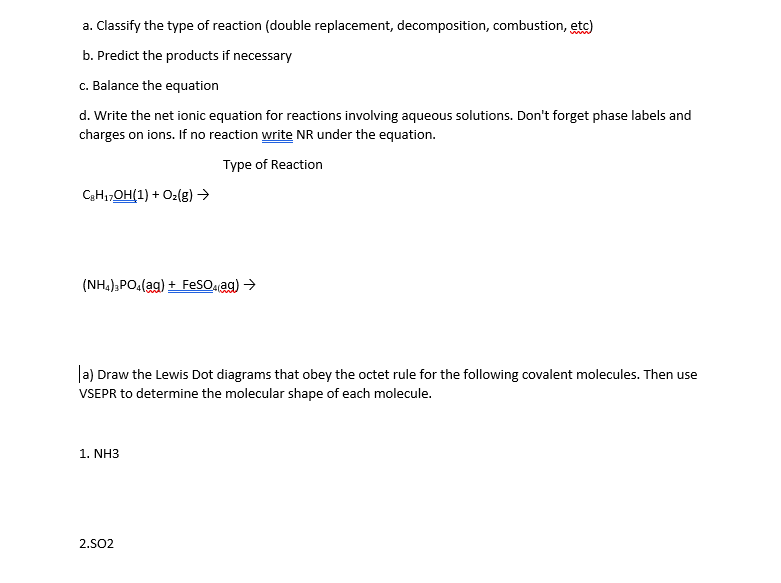a. Classify the type of reaction (double replacement, decomposition, combustion, etc) b. Predict the products if necessary c. Balance the equation d. Write the net ionic equation for reactions involving aqueous solutions. Don't forget phase labels and charges on ions. If no reaction write NR under the equation. Type of Reaction CaH1,OH(1) + O:(g) → (NH,),PO,(ag) + Fesoag) → la) Draw the Lewis Dot diagrams that obey the octet rule for the following covalent molecules. Then use VSEPR to determine the molecular shape of each molecule. 1. NH3 2.SO2
a. Classify the type of reaction (double replacement, decomposition, combustion, etc) b. Predict the products if necessary c. Balance the equation d. Write the net ionic equation for reactions involving aqueous solutions. Don't forget phase labels and charges on ions. If no reaction write NR under the equation. Type of Reaction CaH1,OH(1) + O:(g) → (NH,),PO,(ag) + Fesoag) → la) Draw the Lewis Dot diagrams that obey the octet rule for the following covalent molecules. Then use VSEPR to determine the molecular shape of each molecule. 1. NH3 2.SO2
Introductory Chemistry: A Foundation
9th Edition
ISBN:9781337399425
Author:Steven S. Zumdahl, Donald J. DeCoste
Publisher:Steven S. Zumdahl, Donald J. DeCoste
Chapter7: Reactions In Aqueous Solutions
Section: Chapter Questions
Problem 51QAP
Related questions
Question

Transcribed Image Text:a. Classify the type of reaction (double replacement, decomposition, combustion, etc)
b. Predict the products if necessary
c. Balance the equation
d. Write the net ionic equation for reactions involving aqueous solutions. Don't forget phase labels and
charges on ions. If no reaction write NR under the equation.
Type of Reaction
CH1,OH(1) + O2(g) →
(NH.);PO(ag) + FesO ag) >
la) Draw the Lewis Dot diagrams that obey the octet rule for the following covalent molecules. Then use
VSEPR to determine the molecular shape of each molecule.
1. NH3
2.SO2
Expert Solution
This question has been solved!
Explore an expertly crafted, step-by-step solution for a thorough understanding of key concepts.
Step by step
Solved in 3 steps with 3 images

Knowledge Booster
Learn more about
Need a deep-dive on the concept behind this application? Look no further. Learn more about this topic, chemistry and related others by exploring similar questions and additional content below.Recommended textbooks for you

Introductory Chemistry: A Foundation
Chemistry
ISBN:
9781337399425
Author:
Steven S. Zumdahl, Donald J. DeCoste
Publisher:
Cengage Learning

Chemistry: An Atoms First Approach
Chemistry
ISBN:
9781305079243
Author:
Steven S. Zumdahl, Susan A. Zumdahl
Publisher:
Cengage Learning

Chemistry
Chemistry
ISBN:
9781305957404
Author:
Steven S. Zumdahl, Susan A. Zumdahl, Donald J. DeCoste
Publisher:
Cengage Learning

Introductory Chemistry: A Foundation
Chemistry
ISBN:
9781337399425
Author:
Steven S. Zumdahl, Donald J. DeCoste
Publisher:
Cengage Learning

Chemistry: An Atoms First Approach
Chemistry
ISBN:
9781305079243
Author:
Steven S. Zumdahl, Susan A. Zumdahl
Publisher:
Cengage Learning

Chemistry
Chemistry
ISBN:
9781305957404
Author:
Steven S. Zumdahl, Susan A. Zumdahl, Donald J. DeCoste
Publisher:
Cengage Learning


Chemistry by OpenStax (2015-05-04)
Chemistry
ISBN:
9781938168390
Author:
Klaus Theopold, Richard H Langley, Paul Flowers, William R. Robinson, Mark Blaser
Publisher:
OpenStax

Chemistry: The Molecular Science
Chemistry
ISBN:
9781285199047
Author:
John W. Moore, Conrad L. Stanitski
Publisher:
Cengage Learning